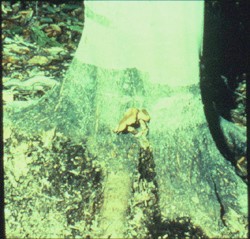
| Home |
| Tutorial |
| Photo Gallery |
| List of Defects |
| Links |
| Bark Distortion |
| Bird Peck |
| Bumps |
| Burls |
| Butt Scars |
| Butt Swells |
| Cankers |
| Conks |
| Epicormic Branches |
| Flanges |
| Flutes |
| Forks |
| Galls |
| Holes |
| Knots |
| Lesions |
| Limbs |
| Ring Shake |
| Rot |
| Seams |
| Soak |
| Splits |
| Wounds |
Significance: A conk usually indicates rot close to or in excess of the percentage of gross volume allowing in a merchantable log of any class.
In veneer logs, the conk along with the accompanying rot is a grading defect, even though a scale deduction is made. The rot results in the loss of some veneer and lowers the grade of some of the veneer produced.
In factory logs, the conk and the associated rot constitute a grading defect. Even if a scaling deduction is taken from the gross log volume, the yield of cuttings from outside the heart center is less than the normal yield. Because stain and insect attack often combine with the rot, a portion of cuttings actually recovered is of lower quality than usual.
In construction logs, the conk is a degrader, for it is evidence of rot in the interior of the log. This excludes the log from this class.
In standing trees, the presence of conks makes it more difficult to determine tree quality. The fungi producing the conks of the fungi's fruiting bodies grow by attacking and breaking down the tissues of another plant-in this case, the wood elements of the tree. A tree with conks contains masses of rotten wood or is hollow where the rotten wood has disintegrated. The extent of rotton wood or hollow can be estimated by sounding the tree with an ax, using a standard increment borer, or using a Shigometer.

